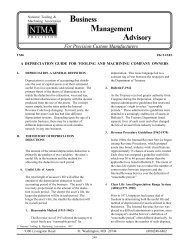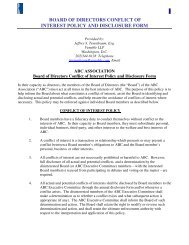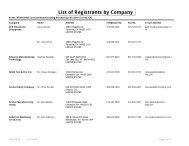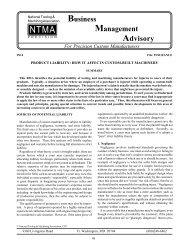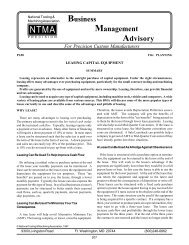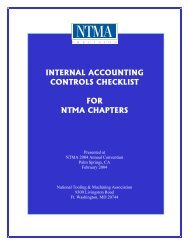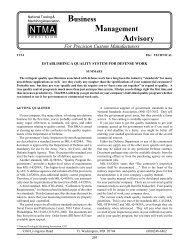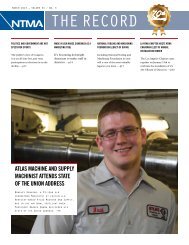President's Committee Planning Workbook
President's Committee Planning Workbook
President's Committee Planning Workbook
Create successful ePaper yourself
Turn your PDF publications into a flip-book with our unique Google optimized e-Paper software.
How to properly Use <strong>Committee</strong>s<br />
How to Avoid Goal-Setting Failures<br />
Sample Mission Statements<br />
How to Manage <strong>Committee</strong>s<br />
How to Choose <strong>Committee</strong> Chairs<br />
How to Assign Goals and Chairs<br />
...complete with forms and worksheets!<br />
Used by<br />
1,000's of<br />
Organizations<br />
to Improve <strong>Committee</strong><br />
Effectiveness<br />
This workbook is not copyrighted, but rather<br />
a "copyFREE" tool you may share with others.<br />
Visit nonprofitcenter.com for additional<br />
copies and other helpful resources.
The President’s<br />
<strong>Committee</strong> <strong>Planning</strong><br />
<strong>Workbook</strong><br />
The workbook is purposely NOT copyrighted. It is meant to be a<br />
copyFREE tool for the use of successive board presidents and shared<br />
with non-profit organizations.<br />
For assistance with leadership orientation, strategic planning,<br />
operating audits, seminars and association operations, contact Bob<br />
Harris, CAE at 850/570-6000 or bob@RCHCAE.com.<br />
If you prefer to order a spiral bound, color, copy send $24 plus $6 s/h<br />
to the following address, payable to “HMG-NPRC.”<br />
Bob Harris, CAE<br />
NonProfitCenter.com<br />
335 Beard Street<br />
Tallahassee, FL 32303 USA<br />
850/570-6000 FAX 850/297-2800<br />
2
Table of Contents<br />
The President’s <strong>Committee</strong> <strong>Planning</strong> <strong>Workbook</strong> ............................................................... 2<br />
Table of Contents................................................................................................................ 3<br />
Congratulations – You are the Chief Elected Officer!........................................................ 4<br />
Introduction......................................................................................................................... 5<br />
First Things First – Gather the Documents......................................................................... 6<br />
Importance of <strong>Planning</strong>....................................................................................................... 7<br />
Using <strong>Committee</strong>s............................................................................................................. 10<br />
<strong>Committee</strong>s Go by Many Names...................................................................................... 12<br />
Avoid Failure .................................................................................................................... 13<br />
Don’t Set Goals in a Vacuum ........................................................................................... 15<br />
The Mission Statement ..................................................................................................... 16<br />
Sample Mission Statements .............................................................................................. 17<br />
Re-Structuring <strong>Committee</strong>s .............................................................................................. 18<br />
Selecting Your <strong>Committee</strong> Chairmen............................................................................... 19<br />
<strong>Planning</strong> Terminology ...................................................................................................... 21<br />
<strong>Committee</strong> Descriptions ................................................................................................... 23<br />
<strong>Committee</strong> Humor ............................................................................................................ 26<br />
<strong>Committee</strong> Volunteer - Form............................................................................................ 27<br />
Goals, Chairs and Vice Chairs - Form.............................................................................. 28<br />
<strong>Committee</strong> Acceptance - Form ......................................................................................... 29<br />
Strengths, Weaknesses, Opportunities & Threats - Form................................................. 30<br />
<strong>Committee</strong>s Recommend; Boards Approve; Staff and Volunteers Implement<br />
3
Congratulations – You are the Chief Elected Officer!<br />
The workbook assumes you are the<br />
incoming chief elected officer 1 of a<br />
board driven, nonprofit organization.<br />
Or, you may hold the title of<br />
president-elect or vice president and<br />
have begun setting goals for your<br />
term of office.<br />
In your important leadership role you<br />
are expected to oversee and guide the<br />
activities and programs that members’<br />
and shareholders expect.<br />
Goal setting can seem overwhelming<br />
at the start of your term --- but it does<br />
not have to be! By considering your<br />
committee choices and charges in<br />
advance or, or early in your term, you<br />
will improve your likelihood of a<br />
successful presidency.<br />
The <strong>President's</strong> <strong>Committee</strong> <strong>Planning</strong><br />
<strong>Workbook</strong> provides a blueprint for<br />
planning your term of office 2 .<br />
By reviewing the essential governing<br />
documents and structure of the<br />
organization; by setting goals and<br />
strategies; by delegating to<br />
committees; and assigning deadlines,<br />
your term will run more smoothly and<br />
be more rewarding for you, your<br />
leadership team and the staff.<br />
1 Synonymous with the title of PRESIDENT, CHAIRMAN, CHAIRWOMAN,<br />
or CHAIR.<br />
2 You are encouraged to share this workbook with your<br />
v ice p residen t or<br />
president-elect so that they too have input into the<br />
committee goals and assignments.<br />
4
Introduction<br />
<strong>Planning</strong> your term of office will be<br />
one of the most important processes<br />
during your presidency. The earlier<br />
you start the planning process, the<br />
better. The planning you do now will<br />
characterize your style of leadership<br />
and most likely determine the<br />
outcomes.<br />
Your aim is to develop a team of<br />
volunteers who understand and agree<br />
with your plan of action. You can<br />
build a corps of volunteers with an<br />
effective structure of committees.<br />
'Failing to plan is planning to fail.'<br />
Ben Franklin<br />
When a leader fails to build a solid<br />
plan, his or her term of<br />
service may end without<br />
any significant<br />
outcomes. Ask yourself<br />
now, “What legacy do I<br />
want to leave during my<br />
term as the chief elected<br />
officer”<br />
If you fail to plan, the<br />
lack of goals and charges<br />
to the leadership and committees will<br />
cause frustration for those who<br />
volunteered their valuable time.<br />
Members, staff and stakeholders will<br />
be looking to you for direction, goals<br />
and the best use of resources.<br />
Without your plan, they will have no<br />
clear direction, allowing crisis<br />
management to take over rather than<br />
maintaining consistent forward<br />
momentum for the organization.<br />
Also ask how you will measure<br />
performance and success during your<br />
term By setting clear, crisp goals for<br />
committees you’ll have a means for<br />
measuring success and keeping<br />
volunteers working on your projects.<br />
If the organization’s constituents,<br />
such as members, prospects, donors<br />
and suppliers perceive that you have<br />
no plan, then their support may<br />
dwindle. They want to know of the<br />
goals set for your term of office.<br />
Use this workbook as a guide to<br />
forming committees, identifying<br />
qualified committee chairs, and<br />
charging them with goals and action<br />
steps 3 .<br />
3 Action steps focus on delegation, accountability,<br />
quantifiability and time frames.<br />
President’s <strong>Committee</strong> <strong>Planning</strong> <strong>Workbook</strong> 5
First Things First – Gather the Documents<br />
As you plan your year of goals and<br />
committee assignments on the<br />
following pages, you will want to<br />
have several documents at hand.<br />
These include:<br />
Mission, Vision and Value<br />
Statements<br />
Bylaws and/or Articles of<br />
Incorporation<br />
Minutes from Recent Board<br />
Meetings (Review any “unfinished<br />
business.”)<br />
Strategic Plan<br />
Annual Budget (Review line items<br />
for priorities.)<br />
Board of Directors Roster<br />
Staff Roster<br />
<strong>Committee</strong> Rosters (Standing, Ad<br />
Hoc, etc.)<br />
Organizational Chart<br />
Other Items to Help you Plan<br />
Review these documents to be sure<br />
your goals and committee<br />
assignments take into account existing<br />
programs and activities.<br />
Also take time to request the input of<br />
others by talking with past leaders,<br />
other board members, current<br />
committee chairs and the staff, about<br />
what they feel should be achieved in<br />
the year ahead. (You don’t want to set<br />
your goals in a vacuum.)<br />
Goal setting doesn’t necessarily mean<br />
writing NEW goals or creating more<br />
work. Some good presidents set a<br />
goal of streamlining the organization<br />
and reducing programs if necessary.<br />
[Some elected presidents view their<br />
term of office as a 100-yard dash.<br />
This is not healthy for the president or<br />
the organization. Think of the year as<br />
being part of a marathon to be run<br />
over several years; recognizing that<br />
certain resources and programs are<br />
already underway.]<br />
Many successful presidents focus<br />
attention on just two or three goals,<br />
and measure their success within each<br />
goal category by defining one or two<br />
strategic outcomes. For example,<br />
within the goal of, “Improve<br />
Government Advocacy,” the<br />
measurable strategy is to “hire a<br />
lobbyist” or “create a political action<br />
committee (PAC).”<br />
President’s <strong>Committee</strong> <strong>Planning</strong> <strong>Workbook</strong> 6
Importance of <strong>Planning</strong><br />
<strong>Planning</strong> defines the vision as to<br />
where the organization should head<br />
during your term of leadership. That<br />
vision affects the day-to-day decisionmaking<br />
processes and the allocation<br />
of resources.<br />
Your plan will<br />
serve as a<br />
compass<br />
or map for<br />
finding ways<br />
to best meet<br />
members’ 4<br />
expectations and<br />
needs. During planning,<br />
consideration must be<br />
given to the availability of<br />
resources, such as funds,<br />
volunteers, staff and<br />
other projects.<br />
While your committee goals will<br />
provide direction, they should remain<br />
flexible --- changing as needs arise.<br />
You may find yourself having to<br />
adapt to internal and external<br />
influences on the organization,<br />
especially technology, competition,<br />
economics, politics, government<br />
regulation, and demographics.<br />
Consider these aspects of planning:<br />
4<br />
Members – synonymous with shareholders,<br />
stakeholders, contributors, donors and interested<br />
parties with an interest in the well-being of the<br />
organization.<br />
• Assumptions must be made for<br />
forming the basis of your goal<br />
setting and committee<br />
assignments. You will have to<br />
make assumptions based on<br />
precedents and needs. For<br />
example, you might assume that<br />
members will renew their dues<br />
next year if their needs continue to<br />
be met. Or, that the economy will<br />
be strong enough that your<br />
organization’s various forms of<br />
income will continue without too<br />
much change. If you know of<br />
negative impacts on the<br />
organization, consider them<br />
carefully as you plan the year.<br />
• The organization’s internal<br />
strengths and weaknesses should<br />
be considered. For example, you<br />
may know that you have a loyal<br />
and trained staff – a definite<br />
strength. An internal weakness<br />
may be outdated office equipment<br />
and computer software. A form<br />
for conducting your own<br />
S.W.O.T. survey – strengths,<br />
weaknesses, opportunities and<br />
threats is included in the<br />
workbook.<br />
• You should take into<br />
consideration external<br />
opportunities and threats. Threats<br />
of terrorism could be an external<br />
weakness that impacts travel to<br />
your annual conference and the<br />
President’s <strong>Committee</strong> <strong>Planning</strong> <strong>Workbook</strong> 7
need to improve on-line services.<br />
New government regulation<br />
requiring members to seek<br />
additional education from your<br />
organization could be an<br />
opportunity.<br />
• A mission statement identifies the<br />
purpose of the organization, who<br />
it serves and what it offers.<br />
Everything in the plan must fit<br />
within the bounds of the mission<br />
statement.<br />
• The organization may have a<br />
vision statement and value<br />
statement. A vision statement is a<br />
long-range, broad visualization for<br />
the organization. (Not all<br />
organizations have a vision<br />
statement.) Value statements, if<br />
they exist, express what the<br />
organization has determined to be<br />
most important. (For example,<br />
being a proponent of diversity,<br />
integrity, and collaboration.)<br />
• Strategies are sub-goals. For<br />
example, you may charge the<br />
Membership <strong>Committee</strong> with<br />
increasing membership by 10%<br />
during your term of office. The<br />
strategies might include “maintain<br />
a retention rate of 95% and recruit<br />
100 new members.” Each goal<br />
you develop will have one or<br />
more strategies for the committee<br />
to achieve .<br />
• Action steps are subheadings<br />
within the goals and strategies,<br />
explaining how they will be<br />
achieved. For example, an<br />
increase in membership is a goal,<br />
and the strategy is to target<br />
student members, then the action<br />
might be to assign a committee to<br />
visit colleges, to have the staff<br />
complete a mailing to students,<br />
and to design a special brochure<br />
for students.<br />
Public Relations Value<br />
A plan has a public relations value if<br />
you take it this far. In addition to<br />
charges to the committees and<br />
priorities to the board, others will<br />
want to know what you plan to<br />
achieve.<br />
You can communicate your major<br />
goals and how they will benefit the<br />
organization, industry, trade, etc. by<br />
distributing a press release, including<br />
it in your<br />
president’s<br />
message,<br />
and/or<br />
creating s<br />
flyer<br />
announcing<br />
the<br />
organization’s new goals.<br />
Adoption of the Goals<br />
Because the president generally has<br />
the power to appoint and charge<br />
President’s <strong>Committee</strong> <strong>Planning</strong> <strong>Workbook</strong> 8
committees, you can probably create<br />
your program of work without the<br />
board’s “blessing.” However, you<br />
may want to ask the board of directors<br />
to review and/or adopt your<br />
committee goals. The board will offer<br />
suggestion that you may want to<br />
incorporate in your plan. This process<br />
creates a “buy-in” among your<br />
leadership team and reminds everyone<br />
that this is the focus for your year in<br />
office.<br />
President’s <strong>Committee</strong> <strong>Planning</strong> <strong>Workbook</strong> 9
Using <strong>Committee</strong>s<br />
The most effective organizations<br />
utilize a structure of committees to<br />
perform the work.<br />
The likelihood of accomplishing your<br />
plan of work – your goals – is<br />
significantly increased by delegating<br />
the work to various types of<br />
committees.<br />
Axiom<br />
<strong>Committee</strong>s are in place to advance<br />
the work of the organization and its<br />
board of directors. Boards should not<br />
do committee work at the board table.<br />
Remember this rule: <strong>Committee</strong>s<br />
recommend, boards approve, and<br />
staff and volunteers implement.<br />
Leadership Development<br />
In addition to getting work done,<br />
committees are an excellent method<br />
for developing leadership skills<br />
among new volunteer leaders.<br />
You will have opportunities to assess<br />
how eager volunteers handle special<br />
projects.<br />
What Kind of <strong>Committee</strong><br />
There are many forms and types of<br />
committees. You will be concerned<br />
with what committees exist in your<br />
organization and your authority to<br />
make changes and appointments.<br />
Typically, the president inherits<br />
committees that were formed through<br />
the authority of the bylaws or by the<br />
precedent of past presidents.<br />
Bylaws generally call for two types of<br />
committees: STANDING and AD<br />
HOC. Take a moment to identify the<br />
committees that exist in your<br />
association.<br />
Standing committees are a relatively<br />
permanent part of the organization's<br />
structure. They continue indefinitely<br />
and are usually described in the<br />
bylaws.<br />
Ad hoc committees are temporary,<br />
and may be called task forces. An ad<br />
hoc committee is formed for the<br />
purpose of handling a specific<br />
concern. When the committee<br />
accomplishes its goal, it disbands.<br />
Project Management<br />
You are encouraged to use a project<br />
management process for achieving<br />
goals. (A good resource on the<br />
Internet is the Project Management<br />
Institute at www.pmi.org.) After you<br />
set your goals, break them into<br />
President’s <strong>Committee</strong> <strong>Planning</strong> <strong>Workbook</strong> 10
smaller components that can be more<br />
easily understood and achieved.<br />
For example, if an increase in<br />
membership is your goal, break it<br />
down into categories of members or<br />
specific quantities. Then consider the<br />
resources each committee has that can<br />
help you achieve the goal. While the<br />
membership committee may be the<br />
first group to assign a task too, also<br />
consider that maybe the convention<br />
committee or education committee<br />
could also be involved in<br />
membership.<br />
Multi-<strong>Committee</strong> Assignments<br />
You can also assign goals to multiple<br />
committees, ask two more committees<br />
to work on a mutual goal. For<br />
example, you might ask the<br />
membership committee and the<br />
publications committee to work on a<br />
special goal of improving member<br />
communications.<br />
delegated work. If this is true in your<br />
organization, you’ll want to consider<br />
your committee charges and how they<br />
affect the budget.<br />
<strong>Committee</strong> Authority<br />
Many organizations make it clear to<br />
committees, usually stated as a policy,<br />
that no committee has authority for<br />
signing or entering into contracts.<br />
The organizations itself, and staff,<br />
should be aware of all contracts and<br />
should not be surprised by the action<br />
of a committee.<br />
Original Works<br />
It is possible that a committee may be<br />
charged with creating a document,<br />
curriculum or program that results in<br />
significant value. Some organizations<br />
require committee members to assign<br />
all rights to the creation of original<br />
works to the organization, making<br />
clear the rights don’t belong to the<br />
committee or its members.<br />
Budgets<br />
Some organizations allocate funds for<br />
the committees to conduct their<br />
President’s <strong>Committee</strong> <strong>Planning</strong> <strong>Workbook</strong> 11
<strong>Committee</strong>s Go by Many Names<br />
Beyond the previously described<br />
standing and ad hoc committees,<br />
today’s organizations are responding<br />
to the limitations and needs of<br />
volunteers by creating new forms of<br />
committees. This is usually the<br />
prerogative of the chief elected<br />
officer.<br />
For example, many volunteers have<br />
limited time to<br />
serve on a<br />
committee. You<br />
can solve this by<br />
charging a task<br />
force or “fast<br />
committee” with a<br />
narrowly defined<br />
task that must be<br />
completed in four weeks. Today’s<br />
younger generations will not serve on<br />
a year-long standing committee but<br />
offer excellent service on short term<br />
projects.<br />
And, by utilizing technology, it is<br />
possible to have committees that<br />
never meet in person but do their<br />
collaboration using web-meetings,<br />
chat rooms, listservs and conference<br />
calls.<br />
Consider how you can utilize various<br />
committee forms to advance your year<br />
of work.<br />
Standing <strong>Committee</strong>s – identified in<br />
the bylaws, appointed annually.<br />
Ad Hoc <strong>Committee</strong>s - formed for<br />
specific or immediate problems or<br />
needs. A.K.A. “fast committees.”<br />
Task Forces – appointed for a<br />
specific purpose, disbanded upon<br />
completion of task. A.K.A. ad hoc<br />
committees.<br />
Knowledge Networks – focus on a<br />
subset of interests; relatively<br />
unstructured; emphasis on<br />
communications among the subset.<br />
Work Groups – similar to a<br />
committee, but with precise tasks and<br />
continuous existence; less “fearful” or<br />
“baggage” than a committee.<br />
Special Interest Groups (SIGs) –<br />
used to represent segments within the<br />
organization.<br />
Virtual <strong>Committee</strong>s – groups that<br />
meet via an on-line forum, bulletin<br />
board, Listserv or chat-room.<br />
Shared <strong>Committee</strong>s - made up of<br />
members from a variety of<br />
organizations; not all from within<br />
your own organization. Expands the<br />
input and resources of the committee.<br />
President’s <strong>Committee</strong> <strong>Planning</strong> <strong>Workbook</strong> 12
Avoid Failure<br />
Goals and plans fail for many reasons.<br />
By considering the hurdles as you<br />
start the planning process you<br />
increase your likelihood for success.<br />
• Failure to be committed to the<br />
plan. It is easy to ignore the<br />
organization's needs while leaders<br />
and staff redirect their time and<br />
efforts to other activities. If the<br />
planning goals are not clearly<br />
delegated and understood then<br />
they probably will be overlooked.<br />
Worse, if the leadership is simply<br />
responding to crises or “putting<br />
out fires,” then your goals will be<br />
neglected.<br />
• Lack of clear, actionable,<br />
attainable and verifiable goals.<br />
Every goal and strategy you write<br />
should include<br />
ACCOUNTABILITY and<br />
MEASURABILITY. To whom<br />
will the work be assigned, are the<br />
goals quantifiable, have you set<br />
reporting and completion<br />
deadlines Vaguely written goals<br />
lead to failure. Be specific as to<br />
what you expect of a committee.<br />
For example, asking the<br />
committee to create an on-line<br />
education course is broad and<br />
without parameters. Rather, ask<br />
the committee to report to you<br />
about the vendors of education, to<br />
conduct a member survey about<br />
education, and to have a written<br />
report ready in three months.<br />
• Underestimating the importance<br />
of the plan leads to failure. That’s<br />
one reason it is suggested that the<br />
board of directors officially adopt<br />
your plan of goals. Remember,<br />
your goals serve as a road map; an<br />
organization without a map will<br />
wander during the year.<br />
Volunteers and staff must be<br />
committed to the plan,<br />
follow its<br />
strategies,<br />
review it<br />
often<br />
and use<br />
it to measure progress.<br />
• Goals that do not “fit” within the<br />
mission statement will cause<br />
confusion and misdirection – and<br />
may create a problem concerning<br />
IRS tax determination. For<br />
example, there is no use asking a<br />
committee to design a lobbying<br />
program, when advocacy is not<br />
part of the mission or may be<br />
restricted by the IRS.<br />
• Unclear committee charges will<br />
sink a plan. First, they must be in<br />
writing --- not just a verbal<br />
comment. For volunteers and<br />
staff to understand your plan,<br />
goals must be clearly explained<br />
President’s <strong>Committee</strong> <strong>Planning</strong> <strong>Workbook</strong> 13
either in the drafting process or<br />
when presenting the goals to the<br />
board and/or committee chairs.<br />
Use action words, verbs, calendar<br />
deadlines and people’s name to<br />
make your goals clear.<br />
your plan in advance of, or early in<br />
your term.<br />
• If you set your expectations too<br />
high, the year will end in<br />
disappointment or perceived<br />
failure. For example, suggesting<br />
that membership can be doubled<br />
may be unrealistic. Be sure goals<br />
and committee assignments are<br />
realistic.<br />
• Too many goals also create a<br />
problem. Prioritize your year by<br />
setting just a few meaningful<br />
goals and strategies to achieve<br />
them. Too many goals and you’ll<br />
exhaust the resources and end the<br />
year in frustration.<br />
• Ego will sink an organization.<br />
One’s personality, biases, and<br />
personal agenda should NOT be<br />
reflected in the committee charges<br />
and work of the organization.<br />
In your role as the chief elected<br />
officer, you<br />
must focus on<br />
writing clear<br />
goals and<br />
strategies at the<br />
start. The forms<br />
at the end of this<br />
workbook will<br />
help you create and communicate<br />
President’s <strong>Committee</strong> <strong>Planning</strong> <strong>Workbook</strong> 14
The chief elected officer should not<br />
set his or her goals and committees<br />
assignments in a vacuum.<br />
Others in the organization<br />
share your concern and<br />
responsibility for the well<br />
being of the association.<br />
Check with your vice<br />
president, the executive<br />
officers, past presidents<br />
and the staff to ask for their<br />
input. Just the process of<br />
asking will indicate that you<br />
value their input and will<br />
result in their “buy-in” to<br />
your agenda.<br />
Don’t Set Goals in a Vacuum<br />
Seek input from:<br />
Board Officers and Directors<br />
Key Organization Members<br />
Carefully consider who to<br />
ask for help, or to identify who has<br />
helped guide the current year. Ask<br />
them for help by sending out a letter<br />
or e-mail message about their own<br />
goals, or bringing them together for<br />
an informal goal setting meeting.<br />
Don’t be afraid to ask stakeholdersmembers,<br />
allies, associates, and staff<br />
what they suggest you set as goals<br />
during your term.<br />
<strong>Planning</strong> Retreats<br />
Some organizations hold an annual<br />
planning retreat for the purpose of<br />
setting goals. Staff or an experienced<br />
facilitator in goal setting and strategic<br />
planning can lead this.<br />
Guests and Consultants<br />
Staff<br />
Other Contacts for Input<br />
President’s <strong>Committee</strong> <strong>Planning</strong> <strong>Workbook</strong> 15
The Mission Statement<br />
Do not proceed without being able to complete this page!<br />
A mission statement defines the<br />
fundamental reason that the<br />
organization exists and establishes the<br />
scope for its major activity areas. The<br />
mission statement is the foundation of<br />
your goals – it drives the organization.<br />
All of your goals should fit “within”<br />
the parameters and intent of the above<br />
mission statement.<br />
The statement should be one to three<br />
carefully worded sentences. It can<br />
usually be<br />
found in the<br />
bylaws,<br />
articles of<br />
incorporation,<br />
in the<br />
membership brochure and/or on your<br />
organization’s Website.<br />
Ask that the mission statement be<br />
included on agendas or on the wall at<br />
meetings.<br />
If for some reason the mission<br />
statement needs attention or editing,<br />
you may want to delegate the task to<br />
the bylaws or an ad hoc 5 committee.<br />
However, changing a mission<br />
statement should be done cautiously<br />
and conservatively.<br />
5 Defined as a committee formed for an immediate<br />
need or purpose. Standing committees are ongoing,<br />
ad hoc committees are appointed and dissolved upon<br />
completion of the task assigned.<br />
President’s <strong>Committee</strong> <strong>Planning</strong> <strong>Workbook</strong> 16
Sample Mission Statements<br />
If your organization’s mission<br />
statement is outdated or needs to be<br />
edited 6 , consider how these<br />
organizations have drafted their<br />
statements.<br />
American Red Cross<br />
The mission of American Red Cross<br />
Disaster Services is to ensure a<br />
nationwide system of disaster<br />
planning, preparedness, community<br />
disaster education, and response that<br />
will provide the American people<br />
with quality services delivered in a<br />
uniform, consistent, and responsive<br />
manner.<br />
Blood Bank<br />
The mission of the blood bank is to<br />
serve our community by meeting the<br />
needs of patients, hospitals, and<br />
members for safe, high quality blood<br />
products and related services.<br />
6 Treat the mission statement with respect. It is a<br />
product of the organization’s founders and submitted<br />
to the IRS. It should only be changed when<br />
essential.<br />
Association of Regulatory Boards of<br />
Optometry<br />
The mission of the Association of<br />
Regulatory Boards of Optometry is to<br />
represent and assist member licensing<br />
agencies in regulating the practice of<br />
optometry for the public welfare.<br />
American Association of<br />
Franchisees and Dealers<br />
The primary mission of the AAFD is<br />
to promote fair and equitable<br />
franchising and dealer practices, to<br />
promote trade and exemplary trade<br />
practices, and to provide members<br />
with programs, services and products<br />
which enhance their ability to conduct<br />
their individual businesses and careers<br />
with competence and integrity.<br />
Builders Association<br />
The Associated General Contractors<br />
[chapter] is the voice of the<br />
construction industry. We are an<br />
organization of qualified construction<br />
contractors and associated companies<br />
dedicated to "Skill, Integrity and<br />
Responsibility." The association is<br />
committed to offering a full range of<br />
quality services to its members,<br />
thereby improving the quality of<br />
construction, advancing the<br />
construction industry and protecting<br />
the public interest.<br />
President’s <strong>Committee</strong> <strong>Planning</strong> <strong>Workbook</strong> 17
Re-Structuring <strong>Committee</strong>s<br />
Many associations, chambers and<br />
nonprofit organizations are<br />
restructuring their committees by<br />
downsizing or eliminating the “dead<br />
weight.” Often committees expand<br />
over time and continue to exist for no<br />
good reason.<br />
<strong>Committee</strong>s exist to serve the chief<br />
elected officer and board; to advance<br />
the mission of the organization.<br />
You do not have to appoint<br />
committees for the sake of appointing<br />
them. Carefully consider if<br />
committees can be combined,<br />
renames or eliminated (if the bylaws<br />
permit).<br />
Who Appoints the <strong>Committee</strong><br />
Members<br />
Precedent and the bylaws will<br />
determine how volunteers join a<br />
committee. As the chief elected<br />
officer, you may appoint them. Or<br />
you may ask your committee chairs to<br />
select members. Your bylaws may<br />
describe the make up of committee<br />
members.<br />
Many organizations survey members<br />
to ask them to volunteer to serve on<br />
committees --- this gives you a ready<br />
pool of members willing to serve.<br />
(Refer to sample form in workbook.)<br />
<strong>Committee</strong> Liaisons<br />
<strong>Committee</strong>s will not accomplish their<br />
work just because goals have been set<br />
for them. It is important that the<br />
president require the committees to be<br />
made up of qualified members, each<br />
dedicated to the association.<br />
You may appoint liaisons from your<br />
board and/or staff to monitor<br />
progress. These liaisons can also<br />
serve as a resource for the committee.<br />
Reporting Progress<br />
<strong>Committee</strong> chairs should be<br />
responsible for reporting to the<br />
president and/or staff. You may<br />
require a written report within [ ## ]<br />
days after the committee meets. Or,<br />
you might ask committee chairs to<br />
periodically meet with the executive<br />
officers. Also, call the chairs to<br />
confirm that they understand your<br />
goals and the associated deadlines.<br />
It is a mistake is to allow a<br />
communication gap between the<br />
committees and the board. It is<br />
frustrating for committees who work<br />
hard but cannot<br />
be represented in<br />
some manner<br />
before the board.<br />
President’s <strong>Committee</strong> <strong>Planning</strong> <strong>Workbook</strong> 18
Selecting Your <strong>Committee</strong> Chairmen<br />
An effective committee requires an<br />
effective chair.<br />
While your committees may be<br />
composed of willing, able and<br />
dedicated individuals, it is the<br />
responsibility of your appointed<br />
chairs to ensure that the committees’<br />
goals are met in a timely manner.<br />
The duties of a good committee chair<br />
include:<br />
• Diligently working to fulfill the<br />
assigned committee goals,<br />
strategies and action steps.<br />
• <strong>Planning</strong> and leading effective<br />
meetings – fostering discussion,<br />
creative thinking, analysis, and<br />
implementation of strategies to<br />
meet goals.<br />
• Motivating members to action, and<br />
following up on their commitments<br />
to accomplish the work.<br />
• Maintaining minutes and reporting<br />
on the progress of work to the chief<br />
elected officer and staff.<br />
• Making the best use of limited<br />
resources, such as time, funds, staff<br />
and volunteers.<br />
• Evaluating the work performed by<br />
the committee.<br />
• Making suggestions to the<br />
incoming chief elected officer and<br />
subsequent committee chairs about<br />
how to improve and more<br />
effectively manage the committee<br />
for the good of the organization.<br />
Qualifications of<br />
the Chair<br />
Because the chair<br />
plays such a<br />
critical role in<br />
completing the<br />
goals you<br />
delegate to the<br />
committee, it is important to review<br />
the qualifications of your candidates<br />
carefully.<br />
Candidates for committee chairs<br />
should have:<br />
• Ability to communicate effectively<br />
and concisely, both verbally and in<br />
writing.<br />
• Willingness to listen to and<br />
acknowledge others’ ideas and<br />
feelings.<br />
• Leadership qualities that motivate<br />
people to action.<br />
• Enthusiasm necessary to take<br />
initiative and accept responsibility.<br />
• Vision to be able to keep the<br />
committee’s action steps in line<br />
President’s <strong>Committee</strong> <strong>Planning</strong> <strong>Workbook</strong> 19
with the goals of the organization.<br />
• Knowledge of the area which the<br />
committee will address.<br />
• Familiarity with the organization’s<br />
operations, history, mission and<br />
structure.<br />
Interview Potential <strong>Committee</strong><br />
Chairs<br />
Allow yourself enough time to<br />
conduct a quality search for your<br />
committee lieutenants.<br />
By carefully considering your<br />
committee chairpersons, you will<br />
enhance the likelihood that they will<br />
advance the organizations mission<br />
and goals. Take time to meet with<br />
them in advance, learning their<br />
interests, recognize their strengths and<br />
weaknesses, and find out if they agree<br />
with your goals.<br />
President’s <strong>Committee</strong> <strong>Planning</strong> <strong>Workbook</strong> 20
<strong>Planning</strong> Terminology<br />
<strong>Committee</strong> goals should be part of the<br />
strategic plan. For that reason, an<br />
understanding of the terms used in<br />
planning can be helpful. Making sure<br />
that other volunteers understand the<br />
terms eliminates confusion and<br />
facilitates the planning process.<br />
Time Frames 7<br />
Often, not all goals can be achieved<br />
within a single term of office (usually<br />
a year.) Thus, assigning time-frames<br />
for completion will improve<br />
understanding and participation by<br />
members and staff.<br />
Note: In today’s fast-paced, uncertain<br />
world, few organizations plan beyond<br />
five years. They focus on the year<br />
ahead and necessary work to be<br />
effective over the next five years.<br />
Short Term (S-T) means actions<br />
within your term of office or the next<br />
12 months.<br />
Intermediate (I) usually means<br />
actions extending into the next term<br />
or calendar year.<br />
Long Range (L-R) means actions 3<br />
to 5 years from now, or even longer.<br />
<strong>Planning</strong> Terminology<br />
7 It is useful to identify the span or term of your planning. For example, retaining<br />
90% of the current members is a short term (S/T) goal while doubling the<br />
membership within four years is a long range (L/R) goal.<br />
Mission Statement is the initial<br />
declaration in the plan that defines the<br />
fundamental reason that the<br />
organization exists and establishes the<br />
scope for its major activity areas. The<br />
mission statement is the foundation of<br />
the organization's plan. The statement<br />
should be one to three, carefully<br />
worded sentences. Mission statements<br />
closely reflect the overall purpose of<br />
the organization as described in the<br />
bylaws or articles of incorporation.<br />
Goals – Synonymous<br />
with “objectives.” Goals<br />
are the major thrusts for<br />
the organization. The<br />
planning process should<br />
result in three to seven<br />
goals. They should be<br />
SMARTER: Specific, Measurable,<br />
Attainable, Realistic, Timely,<br />
Effective & Relevant.<br />
S.M.A.R.T.E.R. Goals<br />
• Specific<br />
• Measurable<br />
• Attainable<br />
• Realistic<br />
• Timely<br />
• Effective<br />
• Relevant<br />
Strategies refer to specific programs<br />
of action requiring a commitment of<br />
energy and resources to achieve your<br />
goals. Strategies complement the<br />
goals; several strategies make up the<br />
plan to accomplish the goals. For<br />
example, a strategy might be to<br />
increase the membership with a<br />
growth of 10% new student members<br />
within 90 days and to lower the dues<br />
for prospective regular members.<br />
President’s <strong>Committee</strong> <strong>Planning</strong> <strong>Workbook</strong> 21
Action Steps are the activities<br />
required to fulfill a strategy and goal.<br />
Action steps are short term and<br />
include specific assignments and<br />
deadlines. For example, “Mary<br />
agreed to contact the community<br />
colleges to acquire a list of graduating<br />
students by May 1 st .”<br />
Integration refers to how the work of<br />
the committee and the goals fit into<br />
the infrastructure of the organization.<br />
A committee’s work must fit within<br />
an existing budget, a strategic plan, a<br />
calendar of activities and other<br />
existing programs and resources.<br />
President’s <strong>Committee</strong> <strong>Planning</strong> <strong>Workbook</strong> 22
<strong>Committee</strong> Descriptions<br />
This is a roster of common<br />
committees and their functions. For a<br />
description of your organization’s<br />
standing committees, check the<br />
bylaws. Ask staff if a listing of<br />
committee descriptions and purposes<br />
exists.<br />
Remember, you may also be working<br />
with other types of committees, such<br />
as task forces, virtual and shared<br />
committees, and knowledge networks.<br />
Executive <strong>Committee</strong> is empowered<br />
to meet in between board meetings to<br />
make decisions and to take care of<br />
issues that arise. The executive<br />
committee is usually composed of the<br />
elected officers plus one or two key<br />
leaders – for example, the past<br />
president or the chairman of the<br />
convention committee. The executive<br />
committee may be limited in action<br />
by the bylaws or policies.<br />
Finance <strong>Committee</strong> directs the<br />
treasury of the organization, as well as<br />
its financial instruments, budgets,<br />
controls and reports. It is often<br />
chaired by the elected treasurer. It<br />
might be responsible for drafting and<br />
submitting a proposed annual budget<br />
for board approval, and may<br />
undertake fund raising projects.<br />
Public Relations <strong>Committee</strong> handles<br />
communications to the targeted<br />
audiences of the organization, who<br />
are generally prioritized in the order<br />
of: (1) members, (2) prospects,<br />
(3) allied organizations, (4)<br />
government, and (5) general public. It<br />
may be responsible for reviewing and<br />
updating publications and acquiring<br />
meaningful articles for a newsletter or<br />
journal.<br />
Membership <strong>Committee</strong> targets<br />
audiences for membership,<br />
successfully enrolling new members<br />
while retaining current members.<br />
Specific, quantitative goals and<br />
deadlines for enrollment and retention<br />
should be set by the president or the<br />
committee chairman. It should<br />
regularly review the organization’s<br />
membership strategies.<br />
Member Services and Benefits<br />
<strong>Committee</strong> coordinates the tangible<br />
and intangible benefits that members<br />
receive by joining and supporting the<br />
organization. It should establish (1)<br />
that there is a member need for the<br />
service; (2) that the service is unique<br />
and available to members only; (3)<br />
that income is received to cover the<br />
administrative costs of the service. It<br />
may enlist outside sources and<br />
providers to create endorsed and<br />
affinity programs.<br />
Government Relations <strong>Committee</strong><br />
reviews proposed laws and rules,<br />
taking timely action to support or<br />
oppose issues that affect the<br />
organization and the profession. It<br />
organizes efforts to block unfavorable<br />
President’s <strong>Committee</strong> <strong>Planning</strong> <strong>Workbook</strong> 23
egulations and support favorable<br />
laws in agencies and in legislature;<br />
and often retains a lobbyist.<br />
Communications and Publications<br />
<strong>Committee</strong> refers to the<br />
communication network developed by<br />
the organization to keep members and<br />
prospects abreast of the organization’s<br />
activities. It may oversee newsletters,<br />
magazines and other communication<br />
tools that reach members and other<br />
audiences.<br />
Education, Seminar and<br />
Convention <strong>Committee</strong> takes<br />
responsibility for meetings sponsored<br />
by the organization. With the<br />
assistance of staff, the committee<br />
should plan cost effective, profitable<br />
events that further the professional<br />
goals of the organization’s<br />
membership. The workload handled<br />
by this committee may require<br />
establishment of subcommittees – e.g.<br />
"trade show" and "continuing<br />
education" subcommittees.<br />
Awards <strong>Committee</strong> implements<br />
programs to recognize members who<br />
contribute beyond the usual efforts. It<br />
may also handle fund raising efforts<br />
for scholarships, and the selection of<br />
scholarship recipients.<br />
Ethics <strong>Committee</strong> is concerned with<br />
image of the organization and the<br />
actions of its members. The<br />
committee may monitor member<br />
actions, handle complaints and<br />
enforce a code of conduct. Consumer<br />
education also may be a responsibility<br />
of the committee.<br />
Nominations and Leadership<br />
<strong>Committee</strong> reviews and makes<br />
recommendations about individuals<br />
who are qualified and willing to serve<br />
on the board of directors. It ensures<br />
that the organization continues to<br />
operate smoothly during transitions of<br />
the organization’s elected officials,<br />
and may be asked to present a slate of<br />
officers to the membership.<br />
Associate or Supplier <strong>Committee</strong><br />
refers to the committee representing<br />
and composed of supplier members.<br />
The committee should provide<br />
valuable opportunities for associate<br />
members and make sure they have a<br />
voice in the organization.<br />
Bylaws <strong>Committee</strong> is responsible for<br />
reviewing and maintaining the<br />
governing documents of the<br />
organization, and for recommending<br />
proposed changes when necessary.<br />
Often the elected secretary is the<br />
committee chairman.<br />
Audit <strong>Committee</strong> is responsible for<br />
selecting the independent financial<br />
auditor, working with him or her, and<br />
carefully reviewing results with the<br />
board of directors. The Sarbanes<br />
Oxley Act requires an Audit<br />
<strong>Committee</strong> for public companies.<br />
Long Range <strong>Planning</strong> <strong>Committee</strong><br />
develops strategic goals for the<br />
President’s <strong>Committee</strong> <strong>Planning</strong> <strong>Workbook</strong> 24
organization. It considers trends that<br />
may affect the organization, as well as<br />
the projected needs, objectives, and<br />
priorities of the membership. Its work<br />
should result in the creation of or<br />
amendments to the association's<br />
strategic plan, which normally covers<br />
beyond the current year, possibly 3 to<br />
10 years in the future.<br />
Technology <strong>Committee</strong> is often<br />
responsible for assessing the best use<br />
of technology (Website, e-mail,<br />
Listserve, etc) to meet member needs.<br />
Additional <strong>Committee</strong> Descriptions<br />
Your organization may have other<br />
committees – include them here.<br />
______________________________<br />
______________________________<br />
______________________________<br />
______________________________<br />
______________________________<br />
______________________________<br />
______________________________<br />
______________________________<br />
______________________________<br />
President’s <strong>Committee</strong> <strong>Planning</strong> <strong>Workbook</strong> 25
<strong>Committee</strong> Humor<br />
As you work on your goals and<br />
committee assignments, you might<br />
enjoy a bit of humor. When you<br />
address the board about committee,<br />
consider using these quotes as an icebreaker.<br />
“To get something done --- a<br />
committee should<br />
consist of three men<br />
--- two of whom are<br />
absent.”<br />
-- Anonymous<br />
“If you want to kill<br />
any idea in the world<br />
today, get a<br />
committee working on it.”<br />
-- Charles F. Kettering<br />
“A committee is a group of the<br />
unwilling, chosen from the unfit, to<br />
do the unnecessary.”<br />
-- Anonymous<br />
“A committee is a group that keeps<br />
minutes and loses hours.”<br />
-- Milton Berle<br />
“Having served on various<br />
committees, I have drawn up a list of<br />
rules: 1) Never arrive on time; this<br />
stamps you as a beginner. 2) Don’t<br />
say anything until the meeting is half<br />
over; this stamps you as being wise.<br />
3) Be as vague as possible; this avoids<br />
irritating the others. 4) When in<br />
doubt, suggest that a subcommittee be<br />
appointed. 5) Be the first to move for<br />
adjournment; this will make you<br />
popular; it’s what everyone is waiting<br />
for.”<br />
-- Greater Kansas City Medical<br />
Bulletin<br />
“A camel is a horse designed by a<br />
committee.”<br />
-- Anonymous<br />
President’s <strong>Committee</strong> <strong>Planning</strong> <strong>Workbook</strong> 26
<strong>Committee</strong> Volunteer - Form<br />
If you are interested in serving on a committee, please complete this form and return it to: (address/fax).<br />
<strong>Committee</strong> appointments are one year in duration in accordance with the bylaws. Some committees may<br />
be shorter ad hoc and task forces. It is recommended that committee members, in accepting<br />
appointments, commit themselves to attending the mid-year and annual meetings, since many meetings<br />
are normally held at these times.<br />
Date _______________<br />
Name, Title, Organization<br />
Preferred Mailing Address (if different)<br />
_______________________________<br />
________________________________<br />
Telephone: Work ________________<br />
Telephone: Home_________________<br />
E-Mail address:________________________________________________________________<br />
<strong>Committee</strong> Preferences (Please rank areas of interest)<br />
____<br />
____<br />
____<br />
____<br />
____<br />
____<br />
____<br />
____<br />
____<br />
Professional Awards and Scholarships<br />
Membership – Recruitment and Retention<br />
Member Benefits and Services<br />
Government Relations<br />
Nominations and Leadership Development<br />
Technology<br />
Professional Development and Education<br />
Finance and Audit <strong>Committee</strong><br />
Chapter Relations and Development<br />
Can you attend the Midyear and Annual Conference yes____ no____<br />
Numbers of years as a member of Organization: _____<br />
Do you have e-mail and check it daily yes____ no_____ Access to Internet yes____ no_____<br />
List any <strong>Committee</strong>s on which you have served, and dates of service:<br />
List relevant background experience for committee assignment:<br />
Thank you for your willingness to serve on a <strong>Committee</strong>.<br />
Please Note: Organization will be the copyright owner of any work created for the committee<br />
President’s <strong>Committee</strong> <strong>Planning</strong> <strong>Workbook</strong> 27
Goals, Chairs and Vice Chairs - Form<br />
Chairman:________________________ Vice Chair:___________________________<br />
<strong>Committee</strong> Members:____________________________________________________<br />
_______________________________________________________________________<br />
Goals (Time Frame: S-T/I/L-R 8 )<br />
1.<br />
2.<br />
3.<br />
Strategies to Achieve the Goals<br />
1.<br />
2.<br />
3.<br />
Action Steps to Achieve the Strategies<br />
1.<br />
2.<br />
3.<br />
4.<br />
5.<br />
Budget (if applicable) $________ <strong>Committee</strong> Type Standing Ad Hoc<br />
Notes to Staff or Board Liaison: The committee needs help with :<br />
8 Short Term, Intermediate, Long-Range<br />
President’s <strong>Committee</strong> <strong>Planning</strong> <strong>Workbook</strong> 28
<strong>Committee</strong> Acceptance - Form<br />
Name: ___________________________________________________<br />
We would like you to accept a position on the __________________<br />
<strong>Committee</strong>. We have an exciting plan of work ahead and know that your<br />
input and ideas will be beneficial.<br />
Please indicate your willingness to serve by this date: ____________<br />
Yes, I accept your invitation to serve on this committee.<br />
No, I cannot accept your invitation. However, as noted below I<br />
can contribute (time, money, gift) as indicated below:<br />
Signature: ___________________ Date: _______________________<br />
Your notes or comments about ideas for the committee:<br />
Please fax or mail your reply to the chief elected officer or to the association<br />
staff as soon as possible. Thank you.<br />
President’s <strong>Committee</strong> <strong>Planning</strong> <strong>Workbook</strong> 29
Strengths, Weaknesses, Opportunities & Threats - Form<br />
Please consider the influences and priorities of the organization and industry.<br />
• Strengths & Weaknesses refer to internal operations of association.<br />
• Opportunities & Threats refer to external factors of association.<br />
(Optional) Your Name_________________________<br />
Company:_____________________________<br />
• What is your #1 expectation of the association<br />
__________________________________________________________________________<br />
• What is the #1 challenge you face in which the association may be in a position to solve the<br />
problem or better serve your needs:<br />
___________________________________________________________________________<br />
List your concerns and issues relating internally to association.<br />
Strengths (internal) (example: stable membership base, good leaders, solid and dues income).<br />
1.<br />
2.<br />
Weaknesses (internal) (example: lack of tangible member benefits, committees, misunderstood mission).<br />
1.<br />
2.<br />
List your concerns and issues outside of the association<br />
Opportunities (external)<br />
(example: demographics, partnerships, privatization).<br />
1.<br />
2.<br />
Threats (external)<br />
(example: gov’t deregulation, salaries, privatization).<br />
1.<br />
2.<br />
Priority - Please identify what you feel should be the association’s highest priority in the<br />
next 12 months.<br />
________________________________________________________________________<br />
President’s <strong>Committee</strong> <strong>Planning</strong> <strong>Workbook</strong> 30
About Bob Harris, CAE<br />
There are 1.4 million nonprofit organizations in the US – including<br />
associations, chambers and foundations. Bob has studied thousands of<br />
them to develop best practices for more effective management.<br />
His career started in Washington, DC, working with Presidential<br />
Classroom and then he moved to Tallahassee, Florida to build an<br />
association management company. He is author of Building an Assoc.<br />
Mgmt. Company and other books.<br />
He teaches association management for Tallahassee Community College<br />
and is on the faculty for the US Chamber of Commerce.<br />
He developed a framework for evaluating nonprofit organizations and<br />
conducts operating reviews for ASAE. The Association Self-Auditing<br />
Process® has been used by 5,000 organizations.<br />
He has received the awards of lifetime achievement, ASAE’s All-Star<br />
Award, and both the executive and the supplier of the year. He has<br />
worked for Hyatt Hotels of Florida for 20+ years.<br />
His systems have been called the Feng Shui of association management<br />
and he’s been called both the Martha Stewart and Dr. Phil of association<br />
management.<br />
His free website has hundreds of pages of management tips and<br />
templates.<br />
Bob’s career passions are demonstrated in two ideals:<br />
• Promoting the impact of nonprofit organizations in America.<br />
• Sharing the tools for helping and boards excel.<br />
President’s <strong>Committee</strong> <strong>Planning</strong> <strong>Workbook</strong> 31
STRATEGIC PLANNING • LEADERSHIP DEVELOPMENT • ASSOCIATION EFFICIENCY





